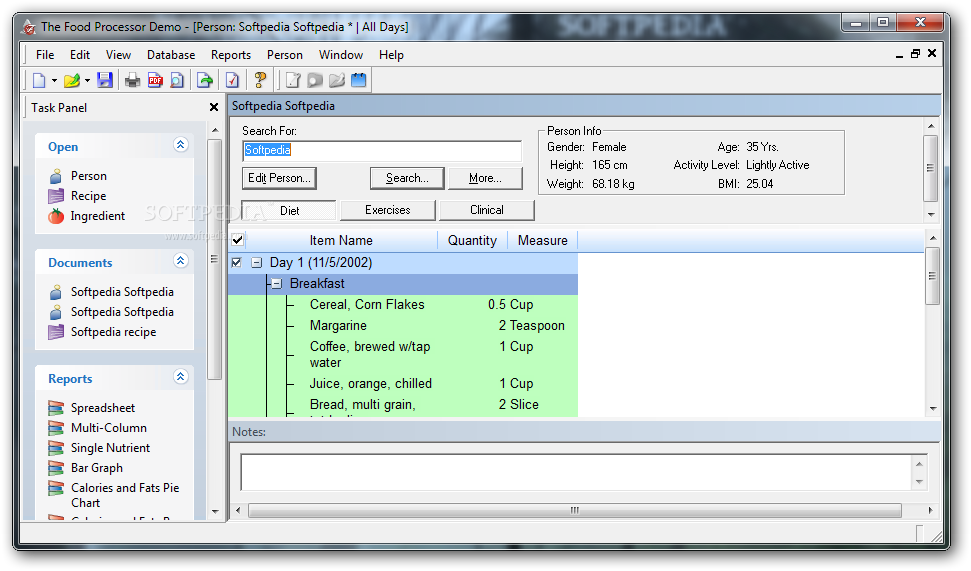Diet Analysis Project for College Dietetics Class: What it Taught Me
/Diet Analysis Using Food Processor Programming
Over this past semester at the University of Arkansas, I was enrolled in two nutrition related classes. In Human Nutrition, my end of the semester project was to consistently track the foods that I ate over a three day period, and use our schools computer program “Food Processor” to analyze my diet in depth. It was awesome to learn how to use this program, in case I needed it in the future, and to see how my day to day diet was affecting my health.
Food Processor
This is a screenshot of the homepage of food processor when entering data to each meal.
Using the Food Processor Program is very simple. I added each food that I ate and the amount that I ate over the course of three days, and the processor prints roughly forty pages of spreadsheets that determined my levels of macronutrients (Carbohydrates, fats and proteins) and my micronutrients (vitamins and minerals). It also shows my percentage of each type of dietary fat (Saturated, monounsaturated, and polyunsaturated) and my percentages of soluble and insoluble fibers.
Over the past three and a half years, I have decided to eat a vegan diet, so I was very excited to see my diet in depth and learn if my levels of vitamins and minerals are still healthy for my age. During my Human Nutrition class, we also learned about the recommended levels of each vitamin and mineral for a healthy body (which are often calls RDA’s, or Recommended Dietary Allowances). I was able to use the information I learned in class to analyze my own averages of micronutrients over the three day period to see where my health stood.
Nutrition Explanations
For more clarity, I want to explain some differences within each nutrient, so my findings from the analysis make more sense! Please remember that I am still a student, so do not make any major dietary changes based on the little information I give below! Always research and ask professionals :)
Macronutrients are needed in larger quantities, hence the “macro”. It does not mean that they are more important for your diet! Each essential nutrient, whether it is a macronutrient or micronutrient, has its own specific jobs within your body. So, micronutrients, although needed by the body in much smaller quantities, are also very important!
In a more technical sense, “saturated fats” are fatty acids in which each carbon molecule is fully hydrogenated (filled with hydrogens). Mono and polyunsaturated fats are also fatty acids, but they are not fully hydrogenated, so they may contain double or triple bonds. Saturated fats are known to increase the body’s LDL cholesterol and promote blood clotting. Because of this it may have an affect on heart disease and other issues. So, it is recommended to have more poly and monounsaturated fats in your diet, rather than saturated fats. The Dietary Guidelines for saturated fat consumption is less than 10 percent of your daily total fat intake, and as little trans fats as possible.
Soluble and insoluble fibers act different in your body. In your body, soluble fibers dissolve in water and form gels that can bind to cholesterol before excretion. This is how fibers have the ability to “lower cholesterol”. Insoluble fibers do not dissolve in water and stay in their original form, but can help with passing stools. Although there are many amazing benefits to having fiber in the diet, having too much can also cause issues. So, it is important to do research or talk to a professional before drastically changing your diet.
My Findings
After tracking my diet for three days and analyzing my data, I found that my saturated fat level was under the recommended maximum of 10% of my daily fat intake, which is very good! I was happy to see that most of the fats that I consumed were from healthy mono and polyunsaturated fats. But, I found that my salt intake was reaching the maximum daily recommendation of 1500 milligrams. It was interesting to see which foods contributed the most to my salt intakes, like condiments, so I can focus on my intakes of these to ensure my salt levels are healthy. I also never realized how much salt that bagels were contributing to my diet, so it was good to learn about these salt levels and determine small changes I may want to make to keep my levels healthy. In terms of Vitamins, I found that my Vitamin B12 levels were low, which is very common in vegan diets. I have been supplementing B12 since I decided to go vegan, so this wasn’t a big worry for me. But, I did see that my Vitamin D levels were lower than expecting, which can in turn hurt the amount of Calcium that my body is able to absorb. Knowing this information, I was able to focus on adding new foods higher in Vitamin D to my diet to ensure that my levels continue to get better.
Overall, it was very rewarding to be able to see how my food choices were directly affecting my health. It made me more curious about nutrient absorption levels, and more aware of the foods I often choose to eat. This analysis gave me motivation to focus more on my health and food choices to be able to stay healthy and also grow in my health.
Although not everyone has access to programs like Food Processor, there are many apps like My Fitness Pal and Chronometer that offer similar opportunities and information to analyze personal diets. I would encourage those who are interested to maybe try out these apps, do some personal research, or reach out to nutrition professionals to make progress in their own personal health!
Happy Eating!
Heidi























